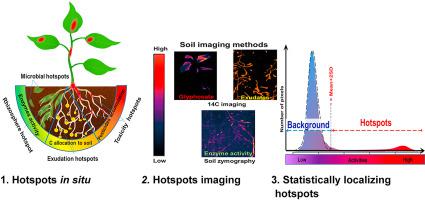Rhizosphere ( IF 3.4 ) Pub Date : 2020-10-15 , DOI: 10.1016/j.rhisph.2020.100259 Nataliya Bilyera , Irina Kuzyakova , Andrey Guber , Bahar S. Razavi , Yakov Kuzyakov

|
The topic of microbial hotspots in soil requires not only visualizing their spatial distribution and biochemical analyses, but also statistical approaches to identify these hotspots and separate them from the surrounding activities (background). We hypothesized that each hotspot type (e.g. enzyme activities in the rhizosphere, root exudation, localization of herbicide accumulation) is a result of local process driven by biotic and/or abiotic factors, and the process rates in the hotspots are much faster than those in the soil background. We further hypothesized that the background and hotspot activities in soil belong to different statistical distributions. Consequently, hotspot determination should be based on statistical separation of activities significantly higher than the background. We analyzed for the statistical distributions of grey values on three groups of published images: 1) 14C images of carbon input by roots into the rhizosphere, 2) 14C glyphosate accumulation in the plant, and 3) zymogram of leucine aminopeptidase activity in rooted soil. The two Gaussian distributions were fit (the first representing the background, the second the hotspots) to the distribution of grey values in the images, the parameters (means and standard deviations, SD) of the fitted distributions were calculated, and the background was removed. Thus, we identified hotspots as areas outside of the Mean+2SD image intensity (corresponding to the upper ~ 2.5% of activity, being over 97.5% of background values) and finally, visualized images of solely hotspot locations. Finally, these results were compared with previously used decisions on hotspot intensity thresholding (i.e. Top-25% and 17 standard thresholding approaches in ImageJ) and discussed the advantages of the Mean+2SD as well as Mean+3SD approaches. These advantages include: i) simple unification of the thresholding approach for several imaging methods with various principles of activity distribution, ii) identification of hotspots with various activity levels, iii) analysis of “time-specific” hotspots in temporal sequences of images. Compared with 17 standard thresholding methods, we concluded that objectively elucidating and separating the hotspots should be based on statistical distribution analysis, e.g. using the Mean+2SD or Mean+3SD approaches. This simple Mean+2SD approach delivered suitable results for three groups of images and so, helps to understand the processes responsible for the highest activities and elucidate hotspots.
中文翻译:

热点有多“热”:在土壤和根际图像上对高活性区域进行统计定位
土壤中的微生物热点不仅需要可视化其空间分布和生化分析,还需要统计方法来识别这些热点并将其与周围的活动区分开(背景)。我们假设每种热点类型(例如,根际中的酶活性,根系分泌物,除草剂积累的局部化)是由生物和/或非生物因素驱动的局部过程的结果,并且该热点中的过程速率比那些中的过程快得多。土壤背景。我们进一步假设土壤中的背景和热点活动属于不同的统计分布。因此,热点确定应基于明显高于背景的活动的统计分离。14 C根部碳输入到根际的图像,2)14C草甘膦在植物中的积累,以及3)生根土壤中亮氨酸氨肽酶活性的酶谱图。将两个高斯分布拟合(第一个代表背景,第二个热点)适合图像中的灰度值分布,计算拟合分布的参数(均值和标准差,SD),并去除背景。因此,我们将热点识别为均值+ 2SD图像强度之外的区域(对应于活动的最高〜2.5%,超过背景值的97.5%),最后,使单个热点位置的图像可视化。最后,将这些结果与以前使用的热点强度阈值决策(即ImageJ中的Top-25%和17种标准阈值方法)进行了比较,并讨论了Mean + 2SD和Mean + 3SD方法的优势。这些优势包括:i)具有多种活动分布原理的几种成像方法的阈值方法的简单统一; ii)具有多种活动水平的热点的识别; iii)图像时间序列中“特定时间”的热点的分析。与17种标准阈值方法相比,我们得出的结论是,应该根据统计分布分析(例如,使用Mean + 2SD或Mean + 3SD方法)客观地阐明和分离热点。这种简单的Mean + 2SD方法可为三组图像提供合适的结果,因此有助于了解负责最高活动的过程并阐明热点。ii)识别具有不同活动级别的热点,iii)分析图像时间序列中的“特定时间”热点。与17种标准阈值方法相比,我们得出的结论是,应该根据统计分布分析(例如,使用Mean + 2SD或Mean + 3SD方法)客观地阐明和分离热点。这种简单的Mean + 2SD方法可为三组图像提供合适的结果,因此有助于了解负责最高活动的过程并阐明热点。ii)识别具有不同活动级别的热点,iii)分析图像时间序列中的“特定时间”热点。与17种标准阈值方法相比,我们得出的结论是,应该根据统计分布分析(例如,使用Mean + 2SD或Mean + 3SD方法)客观地阐明和分离热点。这种简单的Mean + 2SD方法可为三组图像提供合适的结果,因此有助于了解负责最高活动的过程并阐明热点。使用Mean + 2SD或Mean + 3SD方法。这种简单的Mean + 2SD方法可为三组图像提供合适的结果,因此有助于了解负责最高活动的过程并阐明热点。使用Mean + 2SD或Mean + 3SD方法。这种简单的Mean + 2SD方法可为三组图像提供合适的结果,因此有助于了解负责最高活动的过程并阐明热点。











































 京公网安备 11010802027423号
京公网安备 11010802027423号